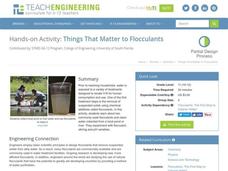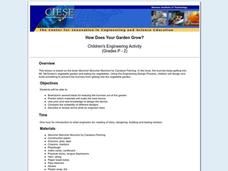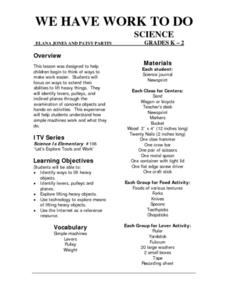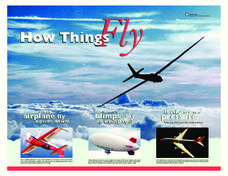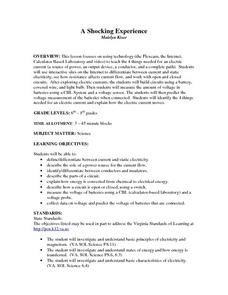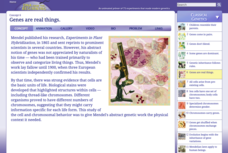Curated OER
Things Fall Apart: Bloom's Taxonomy of Thinking Processes
One of the things that makes Bloom's Taxonomy so effective is that it works off different levels of understanding. Test your readers' knowledge, comprehension, application, analysis, synthesis, and evaluation with these short questions....
Science 4 Inquiry
Investigating How Heat Flows
It is impossible to cool down a glass of water by adding ice. Young scientists explore heat transfer through videos, experiments, and interactive games. They quickly catch on that the water melts the ice and things aren't always as they...
Curated OER
Connect the Spheres: Earth Systems Interactions
Is everything really connected? Take your class on a walk outside, where they will make observations and write them down on a worksheet. Once they are back in the classroom, learners will work to determine if and how things like birds,...
Teach Engineering
Things That Matter to Flocculants
How does the dirt get out of your drinking water? A hands-on activity introduces the use of flocculants to help clear solid particles out of water. The plan walks learners through the process of setting up an experiment that controls the...
Steven's Institute of Technology
How Does Your Garden Grow?
What to do, bunnies are getting into the garden and eating all the carrots! After reading the story Muncha! Muncha! Muncha! the class works together to design a device that will keep those bunnies out of the garden. They get together in...
Curated OER
Explaining How Things Work
Students will focus upon learning how to write an essay based upon observations that are made at a museum. After watching a demonstration or learning how to do something, students write an essay explaining the process to someone who has...
Curated OER
How Long is a Hot Dog? Weight, Weight! Don't tell me!
Primary learners participate in activities that help them explain how different things are measured. They create their own access number chart.
Curated OER
We Have Work to Do!
An excellent lesson awaits your young scientists! In it, learners are invited to explore the world of pulleys, levers, and planes; simple machines that make lifting heavy things much, much easier. They watch video, and engage in hands-on...
NASA
Things Are Not Always What They Seem
Science is magic that works. Magical color-changing beads and a coffee can that follows voice commands are just two examples of magic tricks that rely on science. After completing a hands-on activity and an experiment investigating the...
We are Teachers
NGSS Explained
Here is a very attractive and well-designed infographic explaining the Next Generation Science Standards (NGSS).
Curated OER
How Things Fly
Students explain basic principles of aeronautics such as gravity and lift. In this How Things Fly lesson, students visit the interactive, hands-on How Things Fly gallery at the Smithsonian. Students perform three experiments that...
Curated OER
The Finer Things in Life
Momoyama and Edo are periods in Japanese history that can be defined culturally and artistically. Learners explore and discuss how the samurai used sword guards and grip enhancers. Pupils read the story "The Inch-High Samurai," examine...
Teach Engineering
Rube Goldberg and the Meaning of Machines
A Rube Goldberg machine does not really look like it would make work easier. Introduce your class to Rube Goldberg with a resource that shows how his inventions make simple tasks harder to complete.
Curated OER
Explain and Tell Exercise
In this using forms of the verbs explain and tell worksheet, students fill in the blanks to complete sentences and create additional sentences. Students write 25 answers.
Curated OER
Industrial Revolution
Learners cite the importance of the steam engine, cotton gin and steel making process. They describe conditions in cities due to increased industrialization. They explain how the living and working conditions led to the development of...
Institute of Electrical and Electronics Engineers
Smart Buildings and the Internet of Things
Is your building a smart building? Pupils learn what makes a building smart and about the internet of things. After viewing several videos on the topic, they conduct an activity collecting data from sensors and brainstorm ways to improve...
BBC
Code Calling - Working Out New Words
Young readers practice deciphering new words by using context clues and grammatical rules. The online activity embedded in the plan is especially engaging, and should be enjoyable for all pupils who work through it. A good printable...
American Museum of Natural History
See the Light
It's time to see the light! Scholars perform three different experiments with light to reveal properties using a great remote learning resource. The pupils see how light reflects from a surface and refracts through different materials....
Curated OER
The Physics of Sound: How We Produce Sounds
First graders construct a KWL chart on sound. For this physics lesson, 1st graders describe different ways to produce sound. They explain how sound waves propagate.
Curated OER
Investigation 3 - Terrariums / Aquariums
Third graders create aquariums or terrariums to explain how creatures depend on living and nonliving things.
Curated OER
A Shocking Experience
Learners differentiate between current and static electricity, conductors and insulators, explain how energy is converted from chemical to electrical, measure voltage of batteries, collect data on voltage, and predict voltage of...
Constitutional Rights Foundation
If Men Were Angels: Teaching the Constitution With the Federalist Papers
Much like the methods of group work, the writers of the Federalist Papers worked together to advocate for their viewpoints against the anti-federalists. The resource enables learners to break into small groups and conduct research before...
Cold Spring Harbor Laboratory
Genes Are Real Things
Proving microscopic structures exist is a difficult task. Learn how scientists did just that in the mid-1800s as they set out to identify the cellular structures related to genetics. The online lesson explains the collection of work that...
Curated OER
Things in a Line
Little learners recognize symbols, objects and how to depict numbers. For this matching lesson, they can match the number names with a set of items, model ordinal numbers, and complete a cute, cartoon-character worksheet.





